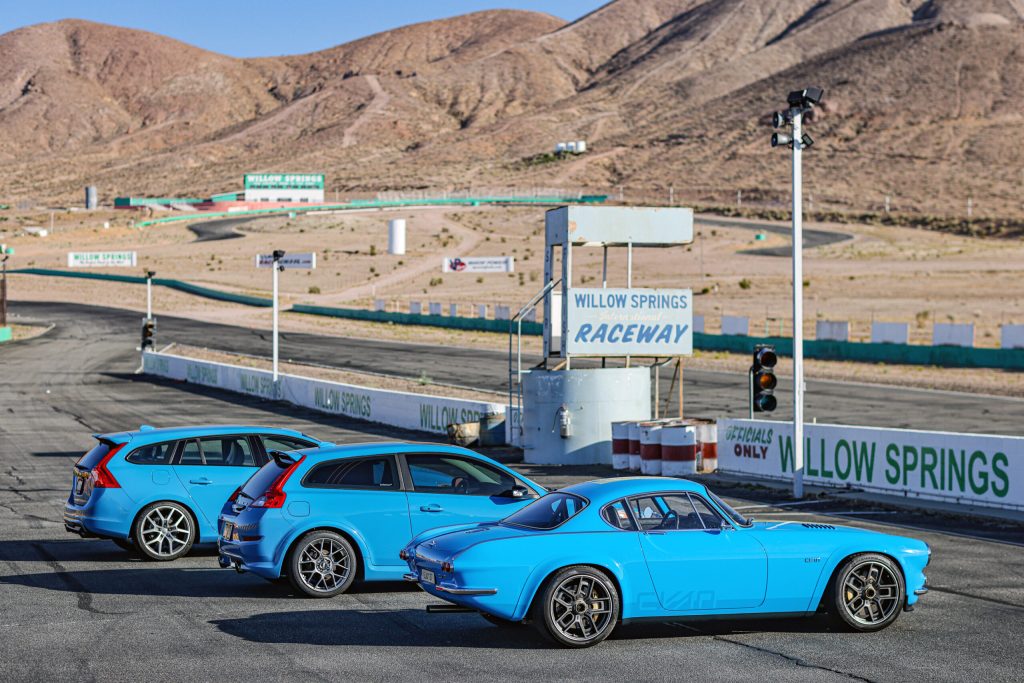Heat haze shimmers over the pavement at Willow Springs Raceway, in California. It’s almost 40 degrees and brutally sunny, the air itself seeming to crisp in the absence of any breeze. Not exactly the place you’d expect to find three Swedish cars. The C30 Polestar Limited Edition, the V60 Polestar, and the Cyan P1800 cool the bleak Mojave landscape with a dash of blue.
Unexpected: Isn’t that the beauty of a hot-rod Volvo? That is somehow nuttier, more joyful than it’s supposed to be?

Now called Cyan Racing, the motorsports team formerly known as Polestar is responsible, to one degree or another, for all three of the hot Volvos at Willow Springs today. You may already be familiar with the latest of these projects, the 1964 Cyan P1800 – a comprehensive resto-mod of the ’60s Swedish sports coupe, complete with a widened carbon-fibre body and turbocharged racing engine from the team’s 2017 World Touring Car Championship car. Next to it sits the V60 Polestar, a rare high-performance variant of Volvo’s luxury wagon produced from 2015 to 2018. The runt of the litter is the 2013 C30 Polestar Limited Edition, the chic city hatchback that first brought Polestar from the race track to public roads.
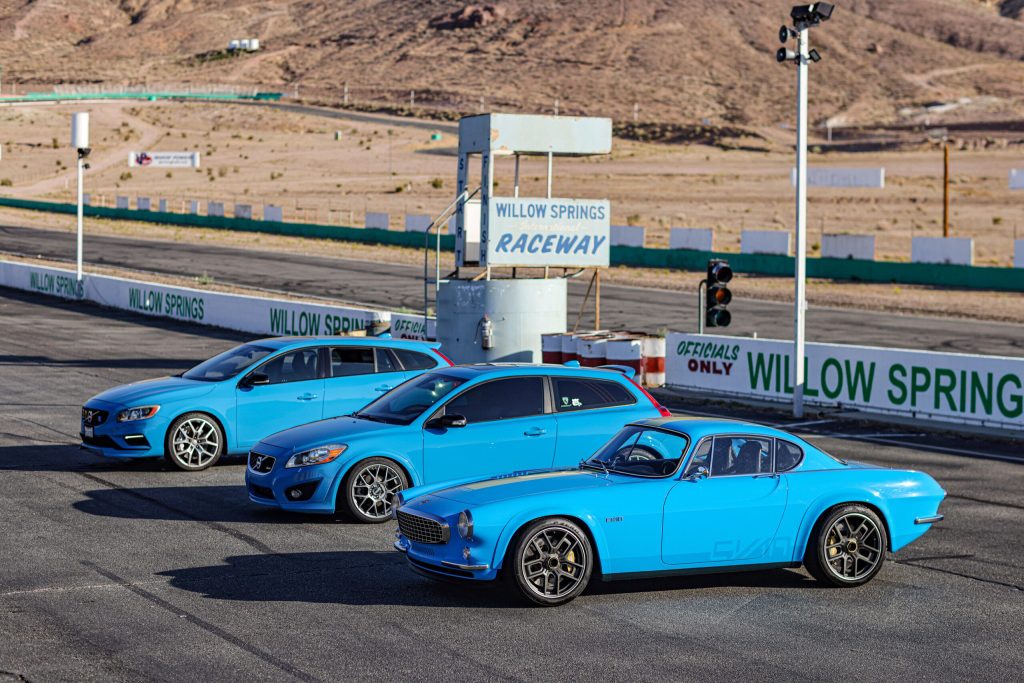
***
In contrast with its reputation for good sense, restraint, and a certain starkness, Sweden is a hotbed of car enthusiasm. There even exists a rabid appetite for American muscle cars in the Nordic country, home to a cult-like contingent that celebrates the brashness and character of the classic Detroit V8.
Historically speaking, Volvos have been largely staid and conservative cars. Still, over the decades, offerings such as the 242 GT, the 740 Turbo, the 850 Turbo, and the V70 R have delighted driving enthusiasts. Enough to indicate there were at least a few employees in Gothenburg keeping the fun-flame burning.
Hans Bååth, Cyan Racing general manager, and Mattias Evensson, head of engineering, are definitely cut from this cloth. Joining us at Willow Springs to show off the Cyan P1800, the Scandinavian motorsport fiends are wearing black shirts on a summer’s day, in the high desert, yet the heat isn’t taking a toll. They are all smiles. Seeing this trio of Volvos, all painted the same Rebel Blue his team first wore for the 2011 WTCC season, is a real treat, Bååth says. And despite the broad spectrum of performance that exists across the trio, he can pull a common thread: “Our philosophy, in racing and on the road, is to give the driver full control, confidence, and predictability. A car that never surprises you all season is one that wins.”
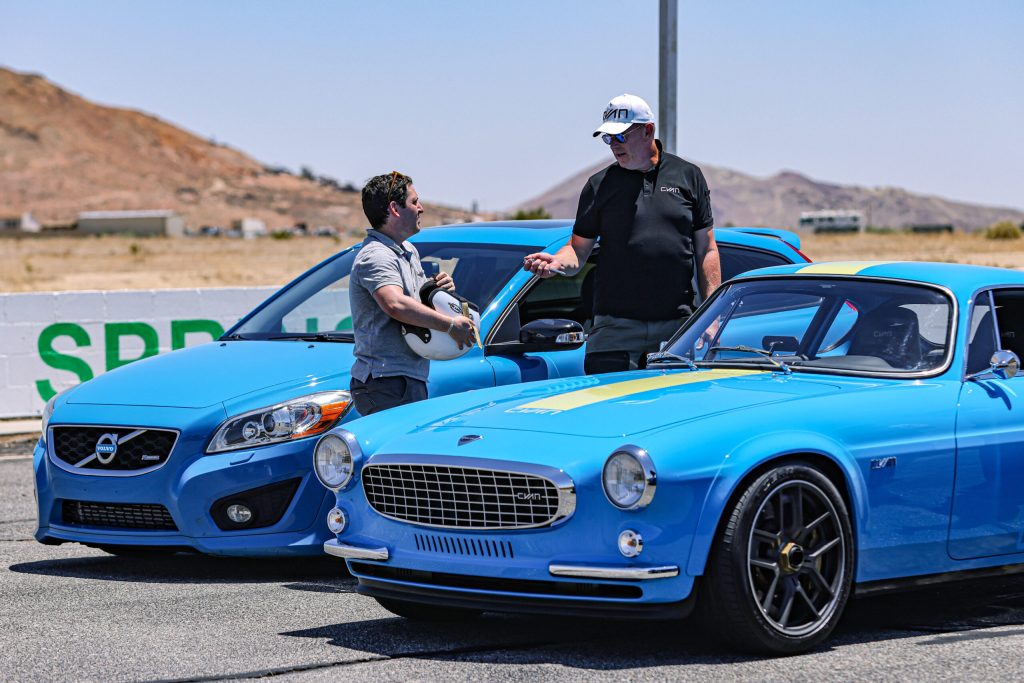
In the last several years, however, Volvo has taken steps to deprioritize high performance in its product planning. To wit: After ending its participation in motorsports in 2017, Volvo parent company Geely rebranded Polestar as a standalone EV marque. All Volvo road cars, in the name of safety, now come with a 112mph governor. And although Volvo offers a powerful “Polestar Engineered” version of its V60, it’s a plug-in hybrid lacking the driving engagement of past fan favorites. This is all somewhat disappointing for Volvo enthusiasts especially, who pined for an in-house performance brand to battle other European powerhouses like BMW M and Mercedes-AMG. A decade ago, Polestar seemed on the cusp of becoming just that.
***
In 2009, Polestar Racing won the drivers’ title in the Swedish Touring Car Championship with Tommy Rustad driving a C30 S2000. That same year, Volvo named Polestar its official tuning arm, aiming to offer warranty-approved performance parts and engine-computer flashes via dealerships.
Part of the marketing campaign for the newfound Polestar Performance tuner brand was a one-off concept car based on the 2010 C30 hatchback. Polestar saw this as an opportunity to take everything it had learned from the racing C30 and create the ideal road car, one its drivers and engineers would themselves want to drive.
The resulting C30 Polestar concept was utterly bonkers: 445bhp and 376lbft of torque from a highly tuned and KKK-turbocharged inline five-cylinder; all-wheel drive; limited-slip differentials front and rear; large Brembo brakes inside forged 19-inch BBS wheels; adjustable Öhlins suspension; adjustable anti-roll bars; an adjustable rear wing; and racing seats with four-point harnesses. Despite the bevy of go-fast parts, the goal of the build was a car equally suited for long, comfortable road trips and the curviest roads. Speed and capability could not come at the expense of friendliness and usability.
Though there were rumors Volvo was pondering a production version to cement Polestar as a proper performance arm, no such car came to fruition. In 2013, instead, Volvo put Polestar in the limelight with the C30 Polestar Limited Edition.
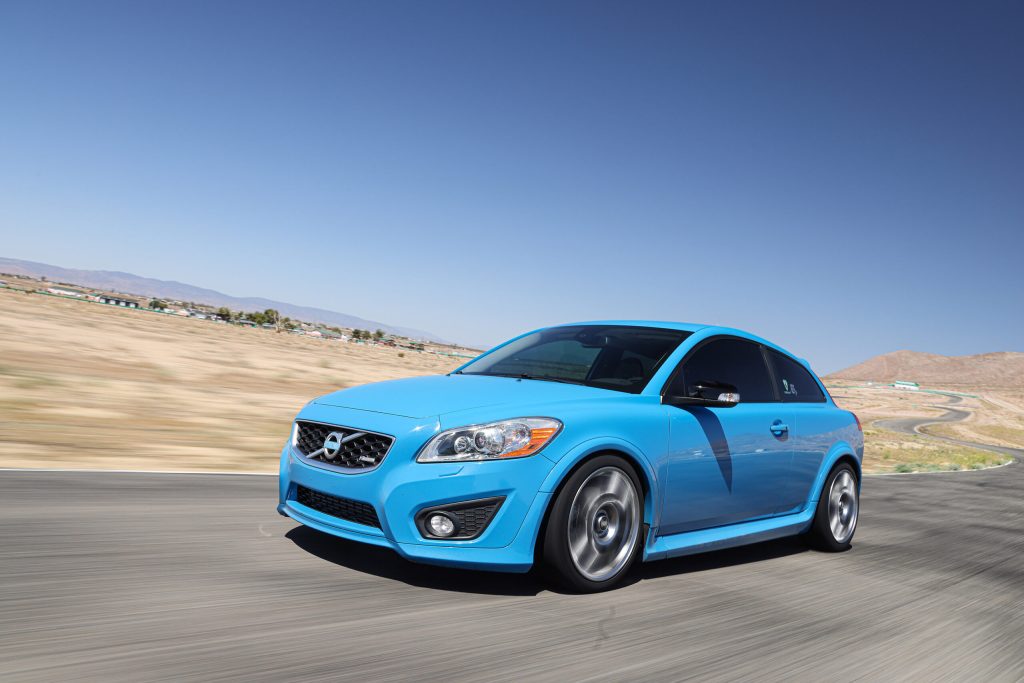
Based on the existing C30 R-Design and offered exclusively in North America, the 250-unit Polestar Limited Edition more or less amounted to a software tune and a Rebel Blue paint job. The engine computer flash, which C30 owners could get themselves for about $1300, upgraded the standard turbocharged inline-five from 224bhp and 236lbft of torque to 246bhp and 273 lbft. It was a long way off from the concept car – much closer to a Volkswagen Golf GTI in final form than the Golf-R-on-steroids competitor that was teased. As a first toe in the water, however, the limited-edition C30 made a certain kind of sense at roughly $32,000 (£19,800) — except for the standard all-season tyres, says Bååth. Summer rubber would have been much more appropriate.
“The all-season tyres were just tough. It almost ruined the whole car,” he says. “For a racing team, that was difficult to see.”
Fortunately, the C30 Polestar Limited Edition we’re admiring in pit lane is wearing summer rubber. The switch to grippier meats is just one of the many changes that owner Mitchell Galles has made. And in the spirit of a spunky tuner car, this C30 sports a number of aftermarket pieces to amp up performance: BBS wheels; a KPax racing exhaust; an Elevate intake, charge plate, and intercooler; and a Bilstein suspension.
It’s a zippy little thing—eager and lively, with a certain darty-ness at low speeds. There’s a rush of turbo noise from the inline-five, complete with a characteristic growl, especially in the upper reaches of the rev range. The C30 makes for an entertaining road car, no doubt, though it is hardly a weapon on Big Willow. The steering becomes vague and distant when the course calls for quicker maneuvers at high speed, and the stock R-Design brakes simply aren’t up to the task after repeated high-speed stops. Though he isn’t interested in turning his C30 into a road-course rat, Galles indeed wants to round out his current roster of improvements with upgraded stoppers. Performance and production numbers aside, this C30 marked the starting point for Polestar in customer hands.
***
Finally, in 2015, Volvo welcomed Polestar totally into the fold, acquiring the company for an undisclosed sum. Polestar Optimization tuning for existing cars continued, either via dealer or factory installation, but the full extent of the collaboration arrived in the shape of two cars: the V60 Polestar wagon and the S60 Polestar sedan. These were moonshot performance cars for the Volvo brand, the closest it had ever come to building an enthusiast offering like the BMW M3. The racing team’s fingerprints were all over the place: manually adjustable Öhlins suspension, thicker anti-roll bars front and rear, a carbon-fiber strut brace, six-piston Brembo front brakes with high-performance pads, and a souped-up turbocharged 3.0-liter inline-six engine good for 340bhp and 369 lbft of torque. (Models for 2017–18 switched to a supercharged and turbocharged four-cylinder.)
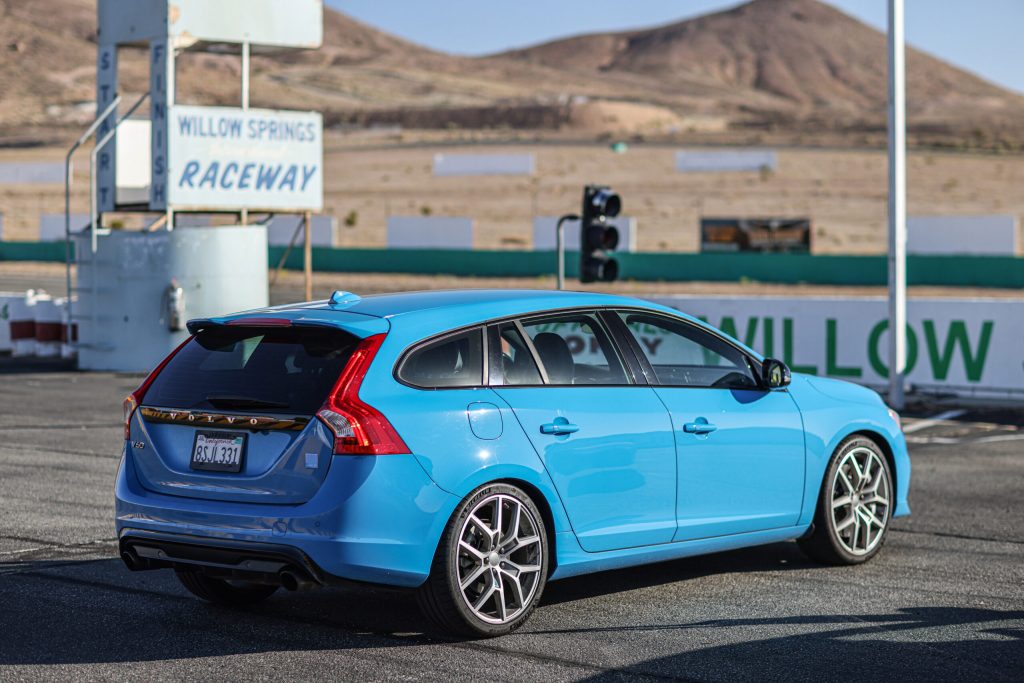
Though only 20bhp more powerful than the V60 R-Design with which it shares an engine, Polestar’s version makes far greater strides with the chassis. It employs stiffer suspension bushings all around, along with 80 percent stiffer springs, and the Öhlins front struts and rear shocks are of the Dual-Flow Valve type, featuring a blow-off valve that maintains consistent suspension behavior on both compression and rebound. The resulting composure is most noticeable over bigger road imperfections and elevation changes.
This is still a reasonably heavy luxury wagon, bordering on 1.8 tonnes. Yet it comes alive in the high-speed sweepers at Big Willow. The front end seems like it wants to wash out and understeer on corner entry, but as soon as the suspension settles and you get on the throttle the whole car finds its balance. Even while pulling considerable lateral g forces, you can make precise tweaks to your line using either the steering wheel or the throttle, with the Haldex all-wheel-drive system favoring the rear axle for torque distribution and the traction control allowing for noticeable slip. Owner Zach Marks has no worries about the brakes holding up, and we run the car six or seven laps in a row before the pedal loses any firmness. Each time it barrels onto the front straight, the bark from the V60’s stainless steel dual-exit exhaust reverberates off of the guard rails.
As with the C30 concept, Polestar’s product brief demanded genuine usability and approachability—more of a thrilling road car than a pure-bred track star. “The V60 Polestar was always envisioned as a sports car that you could drive 365 days a year,” says Bååth. “And getting that through to production meant working within billions of limitations. For instance, it took us months to persuade Volvo to let us do 20-inch wheels.” Polestar also succeeded in specifying standard Michelin summer tyres. As if in celebration of this win, the owner’s manual for the V60 Polestar features a prominent, bolded proviso:
ALL SEASON TYRES ARE NOT ALLOWED ON THIS CAR!
When I point this out to Bååth, he smiles. “That was me.”
For the 2015–16 model years, Volvo built just 1,500 examples of the S60/V60 Polestar, making this Volvo rarer than many Italian exotics. Fans moved quickly to snap them up, paying just north of $62,000 for the pleasure (it was around £50,000 in the UK). Volvo admitted to being surprised at how quickly they sold out. For the V60, at least, save for the six-figure Mercedes E63 AMG, there was no other high-performance wagon on the market; Polestar’s hot hauler was something of a unicorn.
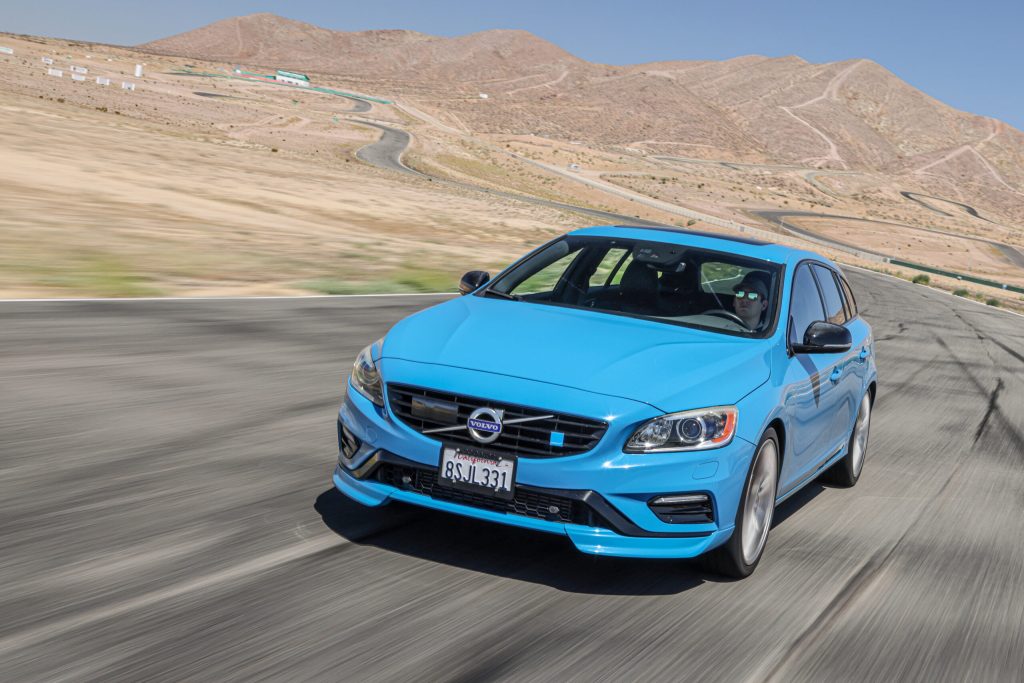
***
Polestar Racing was enjoying plenty of success as well. The team won the driver’s and manufacturer’s titles of the Scandinavian Touring Car Championship in 2013 and 2014, with a custom-built C30, and then took home even bigger hardware in the 2017 FIA World Touring Car Championship with an S60 TC1 race car. (Following Polestar’s acquisition by Volvo in 2015, the team rebranded as Cyan Racing.) After 2017, however, the landscape shifted. The WTCC class series was overhauled, and its successor series did not allow for manufacturer-backed cars. Volvo subsequently pulled out of racing, ending more than two decades of factory support.
The end of that chapter delivered the start of a new one, explains engineering chief Mattias Evensson. “In autumn of 2017, I had a lot of engineers sitting around with nothing to do. Our CEO, Christian Dahl, saw Singer’s work with 911s and wanted to explore something similar with Volvo. That led to the Cyan P1800 – a celebration of our heritage as well as a way for our company to take the temperature for such resto-mods.”
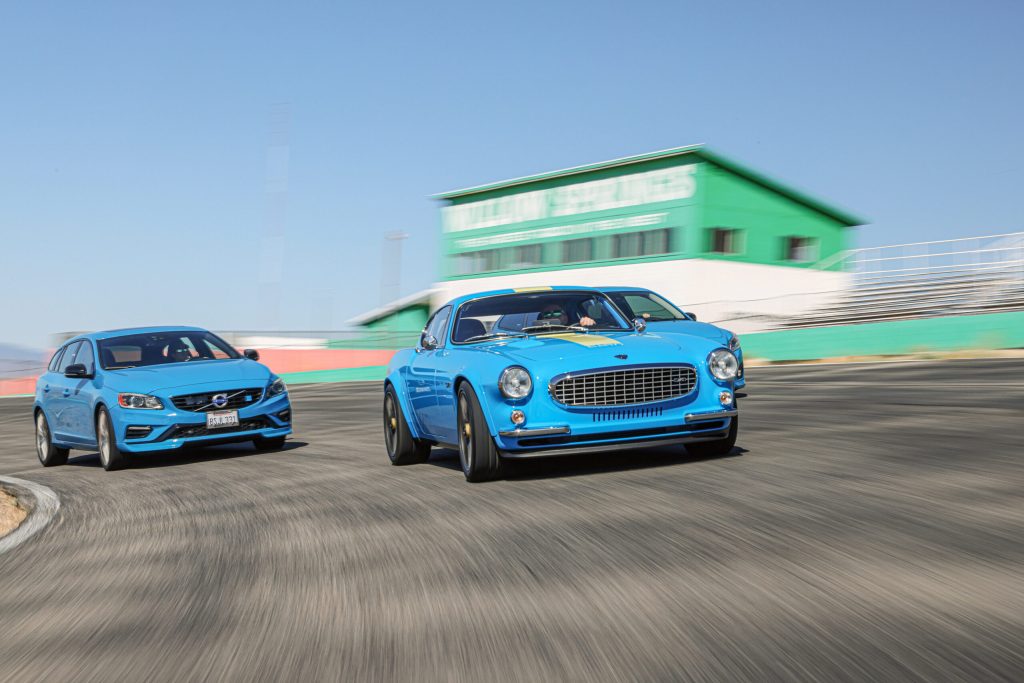
By summer 2018, there was a steel-chassis prototype with the racing engine from the S60 TC1. “We quickly realized that we’d need to do a lot of structural reinforcement,” explains Evensson. “The steel chassis car was twisting so much that the door on the mule would fly open. It was an evolving process. We didn’t know what we were getting into.”
One thing Cyan was sure of? The experience it wanted to deliver for future owners. “You want to feel that you are in control of the car as the driver,” Evensson explains. “That is coming from our race cars and our drivers as well, who want to feel they can push more when they need to.”
Cyan even dusted off its 2010 C30 Polestar concept, repeatedly returning to it during the P1800’s development process to channel the company’s core engineering philosophy: fostering connection to the machine in pursuit of both control and driving pleasure. In the past, that guiding star always needed to be weighed against other restrictions, whether they were the corporate priorities of a global automaker or the strict requirements of an international race series.
With the P1800, the sky was the limit.
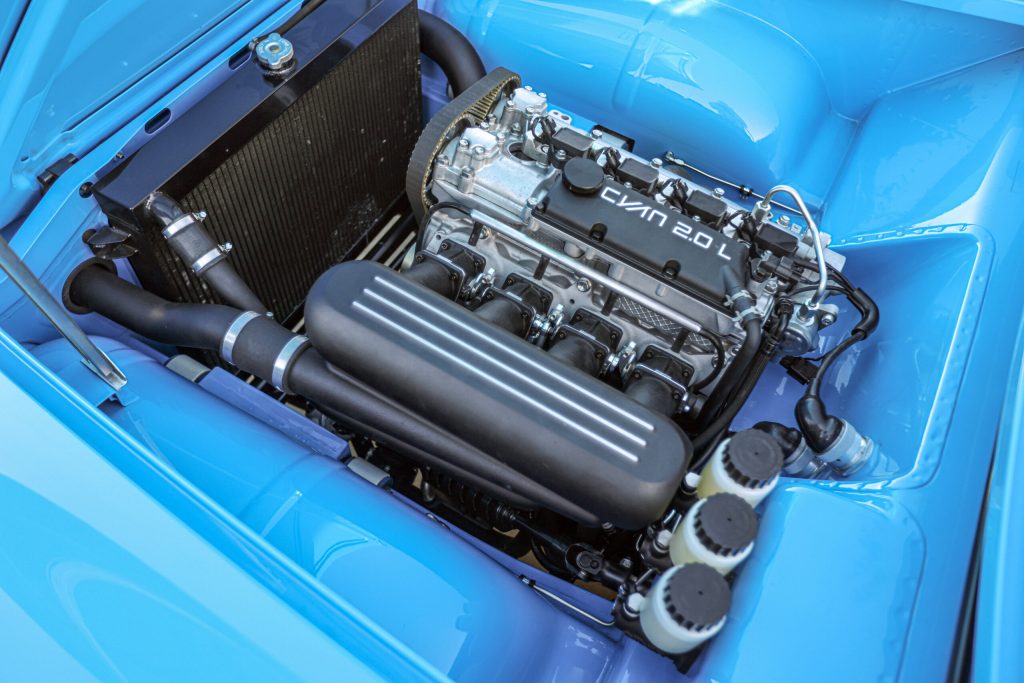
Bååth thought they’d initially use carbon fibre for the fenders, bonnet, and maybe a few other parts, but the team ended up doing the entire body. Cyan strips down the donor car to its bones, sands and reinforces the steel, and then bonds the new body to the chassis using high-strength adhesive. The track is wider to fit the new four-wheel independent suspension and 18-inch forged wheels around AP Racing four-piston brakes. Curb weight is just 990kg—very little for the 2.0-liter, 4214bhp racing engine to grab by the scruff of its neck.
There’s no rulebook for a car like this, so historical accuracy wasn’t a goal. The result, unveiled in 2020, is a kind of fantasy P1800 with the aura of the 1960s but a degree of performance and build precision that far exceeds any mass-produced car of that era. In fact, only the steel in the door pillars and the hood release remain from the donor car, while the original roof and transmission tunnel are augmented with carbon fiber for improved rigidity. The whole cabin is moved rearward, and the overall car lowered, widened, and shortened.
The interior, too, is several notches above any factory P1800. The original layout looks familiar, but the dashboard is all-new, lined in soft-touch leather and a wool-like fabric. Deep bucket seats place you low in the cabin and a four-point racing harness keeps you snug in place. The pedal setup is tight but perfectly arranged, and on the left side of the box is an uncommonly large and useful dead pedal for your left foot. Behind the driver is a titanium roll cage, also wrapped in leather.
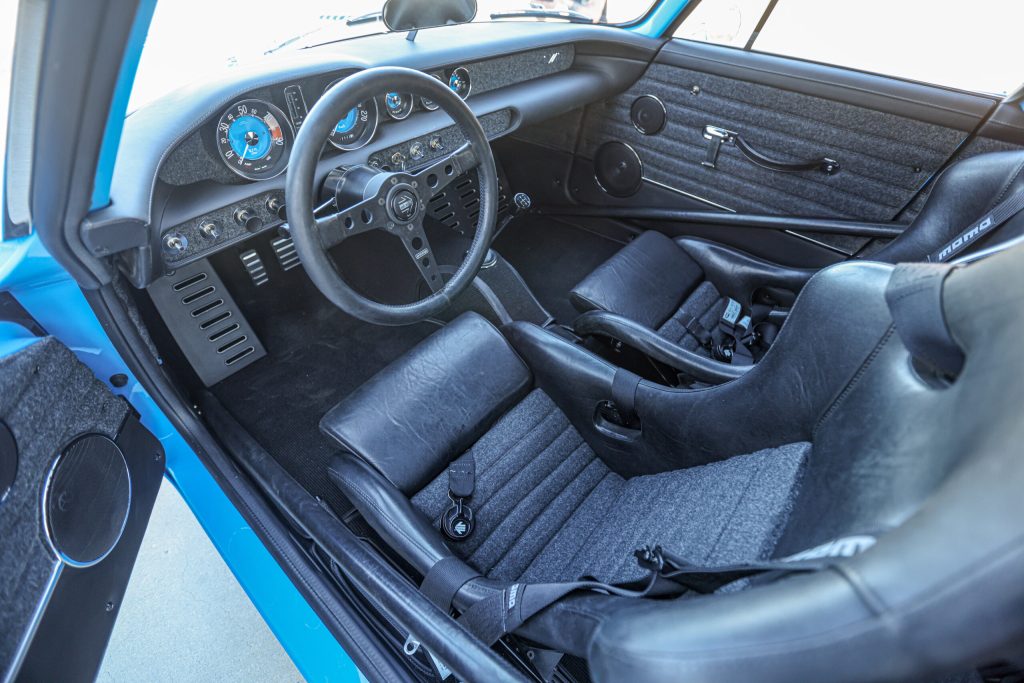
The cabin feels purposeful yet far from unfriendly, despite the fact that many restomods at the price point place a greater focus on luxury appointments. Each Cyan P1800 is built to order, however, so buyers can customize the cabin with materials of their choosing. Though the company has said pricing starts at about £450,000, not including a donor car that can be in any condition, the final build specification for most customers usually brings that tab closer to £550,000.
I fire up the engine and prod the throttle. It sounds like nothing from the ’60s, combining husky four-cylinder rasp with turbo hiss and whoosh. Again, in the spirit of no holds barred, Cyan removed the air restrictor from the turbo that was required for competition. Once warm, the engine settles into a steady but restless idle.
I find first in the Hollinger five-speed racing transmission, and then second, each gear engaging with a pleasant mechanical clack as we gain speed. Every input—from the steering to the clutch action to the brake pedal—requires focus and effort to properly control. The reward is immense feedback and precise response, particularly from the gas pedal, which commands individual titanium throttle bodies. Acceleration is surprisingly linear for an engine pushing 39.1 psi of peak boost; the tach redlines at 7,700 rpm, but the maximum 335 lbft of torque doesn’t hit until 6,000 rpm, and max power not until 7,000 rpm.
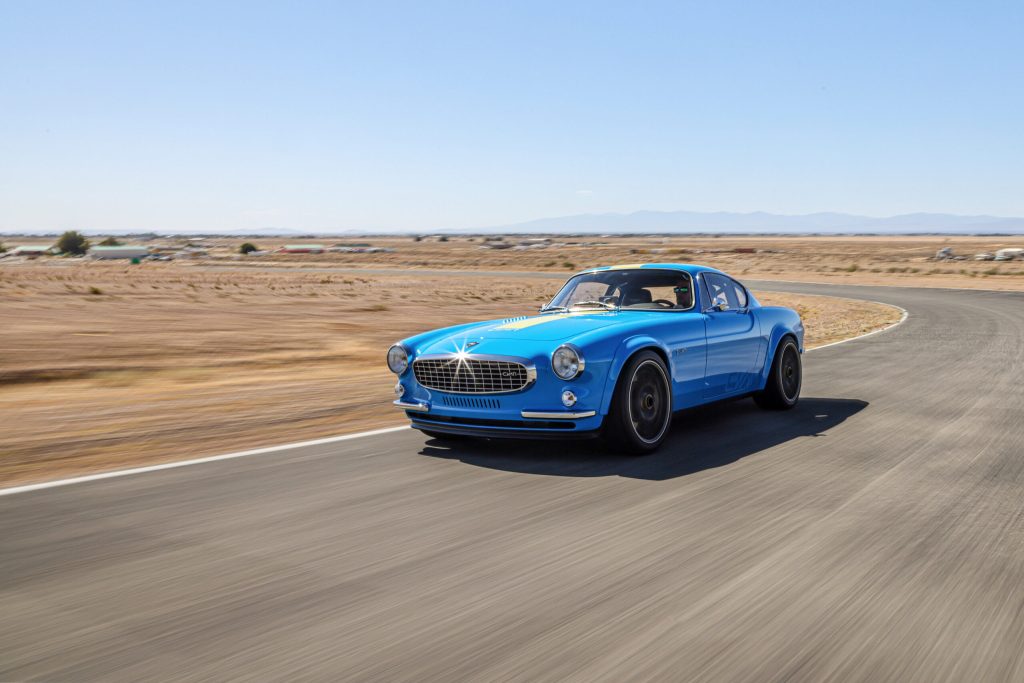
“Make sure you really rev out each gear,” Bååth tells me. “That’s how the car is supposed to be driven.”
After several laps around Willow Springs, I’m most struck by the car’s poise, both in tight transitions and longer, more flowing sections. Even when I brake too late or steer too much or get on the throttle too soon, the P1800 doesn’t bite back. And that matters with no ABS or traction control on board, especially if Cyan wants people to feel like they can drive the car in a variety of situations.
Track driving, however, isn’t something for which the Cyan P1800 was explicitly designed. As a road car, it’s meant to be enjoyed and used in the real world. As such, each example can be individually set up to the customer’s liking thanks to adjustable spring rate, caster, toe, and damper rate. “You need to get it out on the road,” Evensson insists. “Then you’ll understand.”
Oh, to be enlightened. On a canyon road 30 minutes from Willow Springs, the P1800 goes from a warm incandescent bulb on track to a multicolored Roman candle on the road. Thrilling reflexes let you dance from corner to corner. The suspension soaks up the biggest impacts, but you definitely notice the way changes in the road surface and elevation affect handling. Each time the car takes a set of turns feels like an opportunity to get a little more dialled in, a little more intimate with the controls and how to make the most of them.
It requires considerable suspension of disbelief to imagine a P1800 ever driving this well. That’s half the fun of it, though, to experience – in real life – a hot-rod Volvo sports car that never could have existed. Evensson had fun seeing this dream machine from concept through to completion: “Combining modern engineering and old cars—does it get any better?”
***
Cyan’s tooling can support about 100 examples of the P1800. If and when that’s exhausted, Bååth says, he isn’t sure what’s next. The company could simply make more tooling, or decide to move on to another restomod. “The Volvo 140 is the cleanest, most perfect design,” he says. “Or maybe something racier like a 240 Turbo or 850 T-5R.”
Bååth doesn’t seem worried about it. His crew has meanwhile continued racing, with other manufacturers, taking their same driver-centric engineering philosophy to victory: four team titles and two driver’s titles in the last five years of the World Touring Car Cup. Whatever the situation—race car, showroom car, restomod—the Swedes from Polestar/Cyan have proven they can take the heat. Bask in it, even. Whatever they cook up next will be worth the wait.
